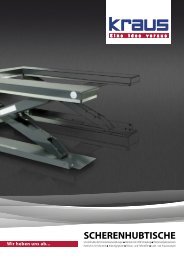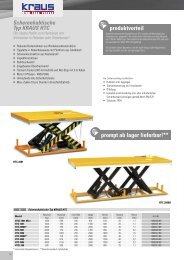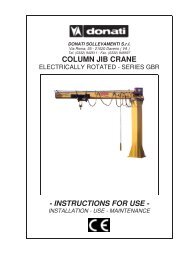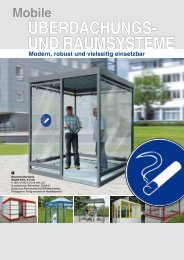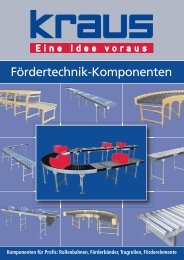JIB CRANES WITH AN ARTICULATED ARM MANUALLY ROTATED
JIB CRANES WITH AN ARTICULATED ARM MANUALLY ROTATED
JIB CRANES WITH AN ARTICULATED ARM MANUALLY ROTATED
You also want an ePaper? Increase the reach of your titles
YUMPU automatically turns print PDFs into web optimized ePapers that Google loves.
DONATI SOLLEVAMENTI S.r.l. - Via Roma, 55 - 21020 Daverio (VA) - Tel. 0332 942611 - Fax. 0332 948597<br />
5.3 - Setting up – Starting the jib crane<br />
To begin operational activities with the crane carry out the following<br />
operations :<br />
1. Visually check the integrity of the crane and the structures on which if installed. Pay particular attention<br />
to the rope, hook and related safety latch.<br />
2. Carry out all preliminary checks as described in paragraph 5.5 “Criteria and precautions of use”<br />
3. Turn on the power supply by putting the main switch in the “ON” or “1” position<br />
4. Ensure that no people are exposed in danger zones<br />
5. Place the red mushroom-shaped “emergency stop” button in the position which allows movement<br />
6. Activate all functions by pushing, if available, the “forward” button.<br />
7. Verify proper functioning of the safety devices by checking the movements as described in paragraph<br />
5.1 “ Functions of the jib crane”.<br />
5.4 Switching off at the end of use<br />
To shut down the crane at the end of work it is necessary to:<br />
1. Position the arm in recovery position ensuring it is stable and taking care that it does not create a risk<br />
of collision or interference with the surrounding structures and/or machines.<br />
2. Free the lifting hook of any slinging used to move the load.<br />
3. Lift the hook, when possible, to a height of no less than 2.5 m so that it does not obstruct or create<br />
danger for people or things below the crane<br />
When a manual hoist is used:<br />
4. Check that the manoeuvre chain does not create risks caused by entangling.<br />
When an electric hoist is used :<br />
5. Halt all the crane movements by pushing the “stop” button on the push-button control panel.<br />
6. Put the push button control panel in the “obstruction“ position<br />
7. Cut off the power supply by turning the general switch to “OFF” or “0” (zero).<br />
5.5 - Criteria and precautions of use<br />
•The correct use of the jib crane guarantees the safe and full performance of the<br />
machine.<br />
•These potentialities are only guaranteed if the following instructions are strictly<br />
adhered to:<br />
• ALWAYS follow the directions and instructions in the use and maintenance manuals and check the<br />
integrity of the components and parts of the crane.<br />
• ALWAYS heed the instructions and warnings displayed on the machine; the warning label plates located<br />
on the crane and in the manoeuvre zone are accident-prevention signs and must always be perfectly<br />
legible.<br />
• ALWAYS ensure that the crane operates in an environment protected from atmospheric agents (rain,<br />
wind, snow, etc.), or, if in the open, that it has adequate shelter or protection.<br />
• ALWAYS check that the capabilities of the crane correspond with the job which needs to be done (work<br />
cycles – intermittence – duration of use – load to be moved).<br />
• ALWAYS check the suitability of the structures (walls,columns,foundations) which support the jib crane ).<br />
• ALWAYS ascertain the adequacy of the state of maintenance of the crane (cleaning, lubrication) and its<br />
main components (hook, chains, push-button control panel, limit switches, motoreducers, wheels, brakes,<br />
etc.)<br />
• ALWAYS verify the correct response of the movements of the hoist.<br />
• ALWAYS test the functioning of the emergency stop button<br />
• ALWAYS check the efficiency of the brakes and of the limit switches and of the electric system.<br />
• ALWAYS check the efficiency of the chain, hook block, hook and push-button panel and that they are<br />
intact.<br />
• ALWAYS ensure that the hook is not worn, damaged or without a spring catch.<br />
• ALWAYS check the suitability and efficiency of the slinging (ropes,chains,bands,...),<br />
42



